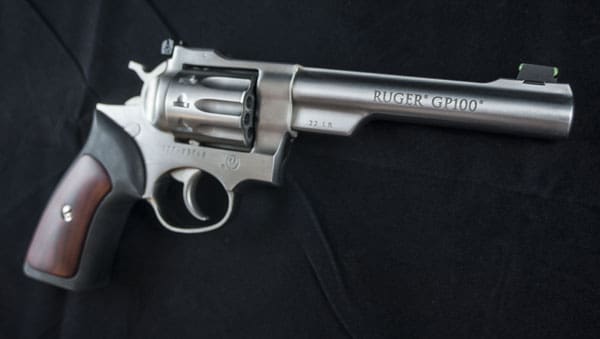
When I think about growing up as a kid, I can’t think of any of the men who owned and worked the farms around us who didn’t have a .22LR revolver. It was always just kind of expected that there was one in the pickup somewhere, maybe next to the work gloves. As there should be. Beyond just being fun to shoot, there are times on a farm when things just have to be done, and those things are most easily done with a rimfire.
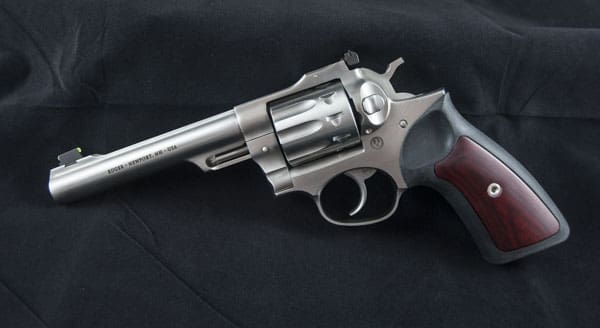
A quick glance into my gun-room reveals six Ruger pistols and two rifles. The first semi-auto I ever shot was a Ruger Mk II I still own and my first revolver was a Blackhawk in .357 Magnum. It killed many a javelina and white tail before I sold it, buying new ones in .41 magnum and .44 magnum, which I still own.
And yet somehow I’ve never owned a GP100. In fact, I’m not sure I’ve ever even shot one. Ruger fans, unclench your pearls. Shooting the .22LR version has me re-thinking that gap in my toolbox.

Taking the Ruger GP100 out of the now very familiar grey plastic Ruger case, I discovered an attractive, working class revolver. The entire stainless steel gun sports a brushed satin finish. Nicely done, but nothing flashy.
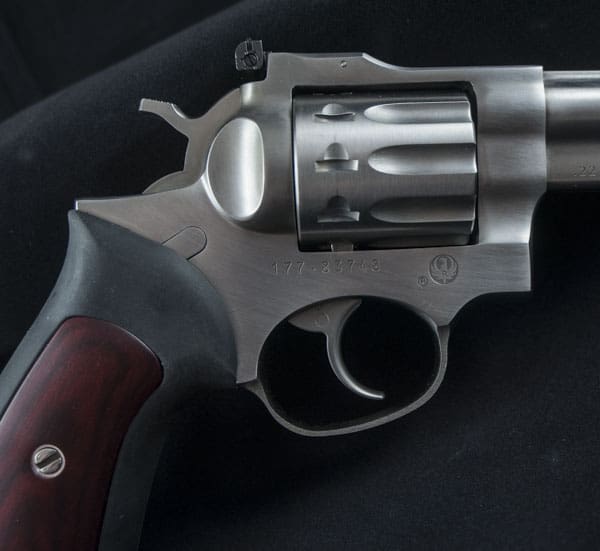
The Hogue Monogrip is fairly utilitarian: a rubber outer grip with hardwood inserts. Surprisingly, there’s no Ruger medallion. But the grip stays put even in wet or sweaty hands. The shelf cut in the left side for your right hand thumb is particular welcome for one-hand firing.

Still, I’m not a fan of rubber grips. I’ve always preferred a solid wood or G10 grip that I can squeeze without any give in the material. Considering the caliber, though, I don’t think recoil’s a concern here. And if you don’t like the grips, a quick internet search reveals a ludicrous number of aftermarket options.
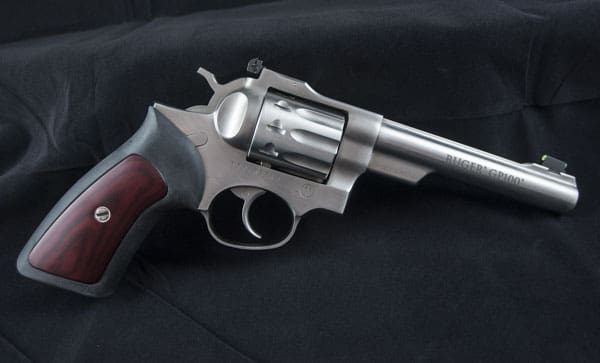
One disappointment: the large “Ruger GP 100” billboard across the right side of the barrel. Not to mention the serial number, caliber, the Ruger emblem and the copyright mark.
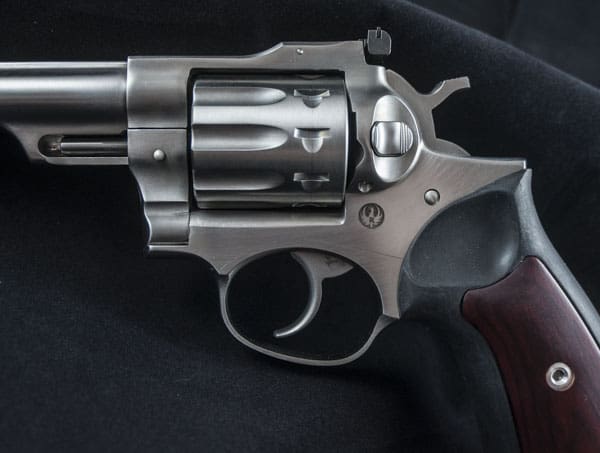
The left side is a little more understated, with just the Ruger logo (this time without the copyright mark) on the frame and the name and city roll-mark on the barrel. The underside of the barrel lug reminds us to “read instruction manual.” Thanks.
While disassembling the GP100 .22LR, doesn’t unearth tool marks, none of the parts are particularly polished, either. There are a lot of fitting lines on the revolver. This is especially noticeable just above the trigger, where the long line of the trigger guard assembly meets the frame. I kept thinking the gun was scratched, but it’s just where the two sections meet up.
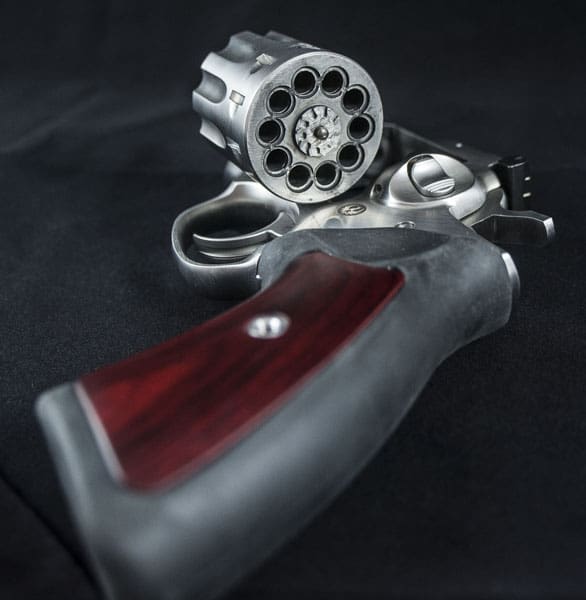
Although the GP100’s well put together, nothing on the pistol’s particularly tight. There’s definitely some play in the cylinder even after lockup. The upside: the gun is a breeze to disassemble and clean, especially for a double action revolver. The only tool you’ll need is a basic flathead screw driver. And for once, the manual clearly walks you through the process. If you’ve ever reassembled the Rube Goldberg-ish Mark II, this is child’s play.

The .22LR GP100 isn’t a six-shooter. It’s a 10-shot revolver. That’s much appreciated, if not a little time-consuming to load. Like all GP100 models, it’s safe to carry on a full cylinder; the patented transfer bar means that the gun only goes bang when you pull the trigger.
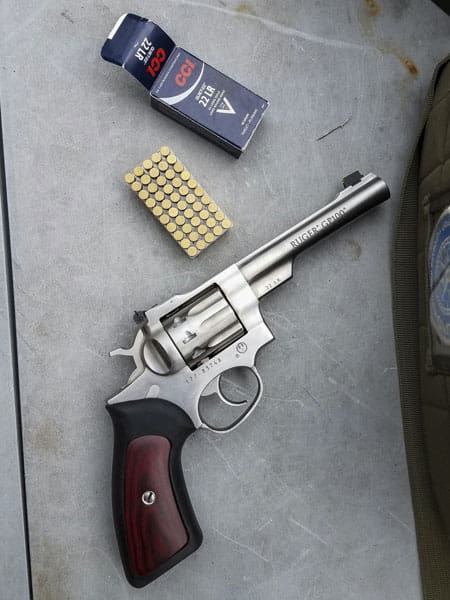
Even though this model is “only” in .22LR, Ruger hasn’t scrimped here in comparison to their larger caliber brethren. It’s the only model listed without a full underlug, but at 42oz, it certainly doesn’t need the extra weight.

The 5.5” barrel maintains the same full outside diameter of the larger calibers. If you wanted a .357 for self-defense and hunting and the .22LR for light work, both wheel guns would feel the same in your hand, and, of course, have identical manuals of arms.
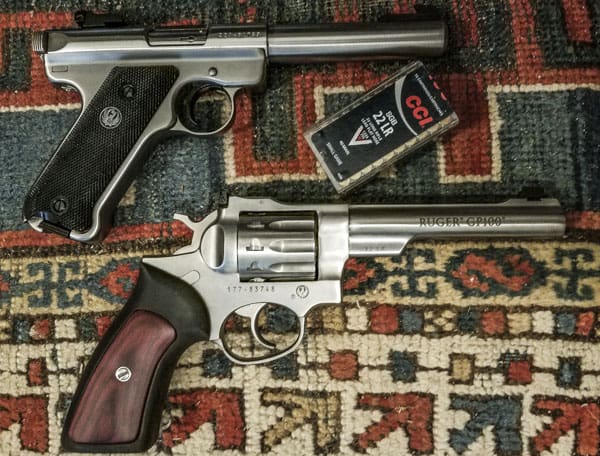
I was always a bit disappointed with both my Redhawk and Blackhawk triggers, so I wasn’t expecting much from the GP100. I was mistaken. Yes, it is heavy. The factory trigger is listed at 14 lbs. and it’s every bit of that. But after just a bit of hesitation at the start, the double action trigger is smooth all the way until it breaks, with no stacking.
That early hesitation, which occurs before the hammer or cylinder start moving, makes the trigger feel heavier than it really is. In single action, there’s the tiniest bit of pre-travel followed by a crisp, easy break. It’s far better than my stock Blackhawks, including my Bisley Hunter.
If, however, you’re determined to lighten the pull, there are aftermarket options available to you. I’d leave it alone, but it’s work that any intelligent adult should be able to accomplish without a professional gunsmith.


One more note on that trigger: the GP100 has a considerable length of pull. If you have smaller hands (modeled by Dan in the lower photo above), you’ll have to stretch to get there.
As far as reliability, there were no unhappy surprises. (After an initial application of RAA’s Gun Oil no additional lubrication or cleaning was performed.) The GP100 is boringly reliable . . . as it should be. Over two weeks’ time, I put 500 rounds of various .22LR cartridges through the gun with zero issues at all. Pretty much what you’d expect.
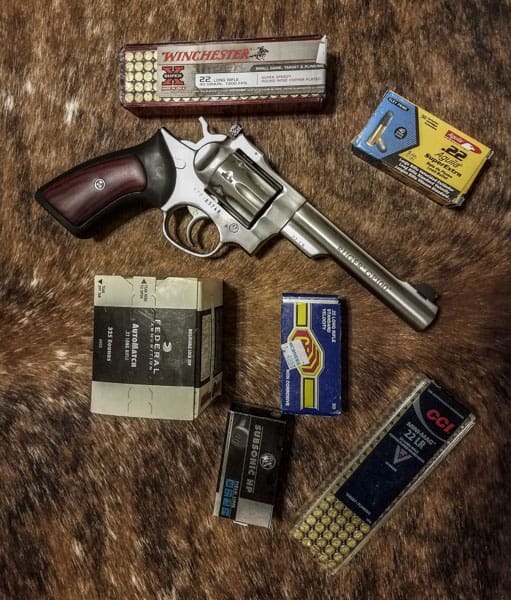
The GP100’s cylinder release button depressed easily enough, but it always took a good push with my palm to get the cylinder to swing out, as well as a push to get the cylinder back in. If you’re used to just flicking your wrist, this revolver requires a little more effort. That’s really the story of the gun as a whole: everything works, but nothing is super smooth.
If your goal is to take varmints such as the constant corn-thieving raccoons around our farm, the accuracy level of the GP100 is plenty good for body shots off-hand at 25 yards.

Shooting from bags at 25 yards in single action, I was getting 1.5” to 1.8” five-round groups, depending on the round used. At 50 yards I could place every round inside a 19” silhouette offhand, but the rounds were all over the target.
Part of that’s the arrow, but a big part of that’s the Indian. The sights are outstanding. The rear sight is easily adjustable with a small screwdriver, a flat black ledge with a bright white outline. The front sight is ideal for general use, a green dot fiber optic sight that really pops out in any light. There’s just a little space on either side of the front sight when aiming, plenty to see your target through, but not too much to be a detriment to accuracy.

I wish the Blackhawks shipped with these sights; they’re the most effective on any stock revolver I’ve seen. As with the grips, there are many aftermarket options available if you fancy something different.
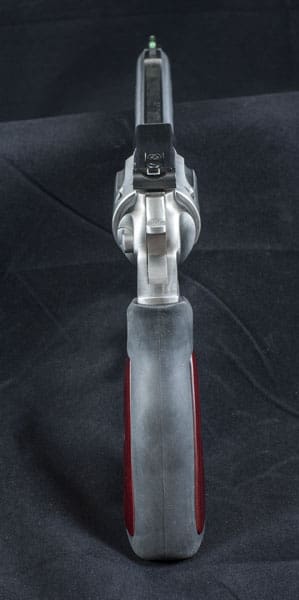
This pistol is heavy, only 2 oz lighter than my 7.5-inch Ruger Bisley in .44 Magnum. Assuming they can work the trigger, even the weakest grips and smallest adult frames can fire the GP100 in .22LR. It’s also fairly quiet, for a pistol. With CCI Quiet-22 rounds, I could avoid ear protection for a cylinder at a time and suffered no ringing or pain in my ears. Don’t try that at home, kids.
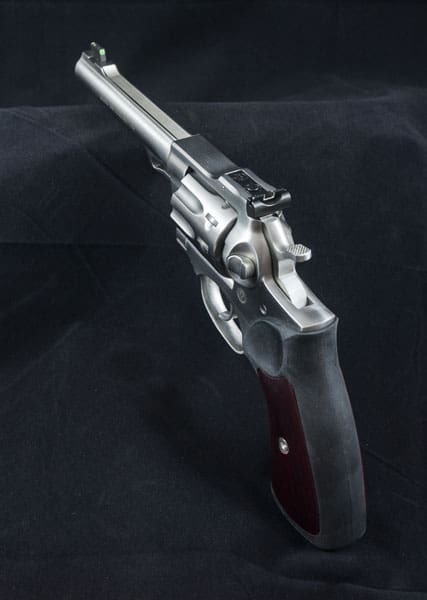
The Ruger GP100 in .22LR is a quality revolver at a decent price. Ruger just announced a .44 Special version of the GP100 coming soon. Based on my experience in .22LR, I look forward to trying out the GP100 in a frequently forgotten, always outstanding self-defense caliber. I imagine a GP100 in .44SPL or .357 Magnum is in my future.
Specifications: Ruger GP100 .22LR
Grips: Cushioned Rubber with Hardwood Insert
Front Sight: Fiber Optic
Barrel Length: 5.50″
Material: Stainless Steel
Capacity: 10 rounds
Rear Sight: Adjustable
Finish: Satin Stainless
Overall Length: 11.30″
Weight: 42 oz.
MSRP: $829.00 (Found easily online for $150 or less than MSRP)
Ratings (out of five stars):
Style and Customization * * * *
This is a working gun and it looks the part. The finish is a well done satin, with no obvious tool marks inside or out. The grip could be prettier. There’s nothing particularly polished about this revolver. There’s an extremely large array of aftermarket options available.
Reliability * * * * *
Shoots everything just fine. I put six different flavors of ammo through it with zero issues.
Accuracy * * *
With groups averaging 1.5” at best, this is an average shooter. At this price level, I’d expect to be more in the 1-inch neighborhood. A little disappointing since my single action Rugers shoot better in heavier calibers.
Overall * * * *
This is what I’ve come to expect from Ruger and why I have so many of their firearms. Overbuilt, heavy and not particularly pretty. Also unfailingly reliable and a solid value.




I bought one for the kids to shoot.
I took it to a gun smith to lighten the trigger pull.
There is only so much that can be accomplished in that department.
However, a word of caution: the Ruger mechanism is different from a S&W mechanism and the reset is just clicketty-clunky with an annoying two-click reset that is more pronounced and far less smooth than those two-click LC9 resets.
Still, a decent gun.
42 ounces unloaded? Whoa!
My Ruger Alaskan in .44 is only two ounces more and requires a heavy gun belt or shoulder rig.
Ah, another Alaskan owner! I had a hard time rationalizing that purchase, but I have no regrets. My favorite handgun to shoot, easily. Didn’t want the .454 Casull, wanted the .44. So I bought it.
There’s just something about this gun, to my eyes. One of the few “obscure objects of desire” that i did not resist the impulse.
Carry on.
‘The factory trig ger is listed at 14 lbs and it’s every bit of that.’
I believe that’s a 14# ham mer spring, not the weight of the trig ger pull. I put Wil son Com bat spring kits in both of my GP 100s (both .357) and the stock springs were 14# for the ham mer spring and 12# for the trig ger return spring. I installed 10# ham mer springs and 8# trig ger return springs which made a pretty significant difference. No light primer strikes. Kits run about $10 and take about an hour for a novice, counting You Tube instructional.
You can get alternate side panels for those grips from Altamont which are prettier and offer checkering. Just about everyone who handles mine love the grips regardless of hand size.
There were some edits about the trigger that didn’t make it into the final article.
In short, the heavy spring serves its intended purpose, which is to ensure that any rimfire round goes off. I have seen a lot of lighter triggers fail to set off the wide and varied range of rimfire rounds.
The GP100 strikes with authority.
The trigger reach itself will be a problem for some people. Partially because it’s stacked so heavily at the front of the pull, not at the back of the pull. My hands were plenty large enough to get all the way into the trigger and then some.
RF’s hands left his trigger finger in the perfect position to stroke the lever. Dan could barely fit his trigger his finger on the trigger face. Considering the grips are easily changeable, an aftermarket grip might help a little with that.
But some people with small hands, or children, might be forced to shoot this gun in single action mode only.
It’s quite possible that the rim fire model required a heavier ham mer spring than the centerfire models. I’m sure you could swap out the trig ger return spring without any negative effects, but the ham mer spring might come at the price of a few misfires.
DA trig ger reach will always be an issue for shooters with small hands. The Single Ten might be a better choice for some and it saves 4 ounces and $130 (MSRP). DA shooting is a bit overrated in my book anyway. I do just enough to keep reminding myself that if I need fast accurate shots out farther than 15 yards or so I’m better off thumbing the ham mer back. I think the .22LR GP 100 is more aimed at people who already love the platform and want a .22 version. But it’s a big gun, there’s no getting around that.
I have the Single Six with the LR and Mag cylinder. It’s very good at what it does. Double action in a .22, unless it’s a self defense gun, isn’t really needed.
Even in a self defense weapon, the greatest advantage (by far) to a DA/SA revolver over a SAA is the speed of the reload.
I would not go with single action in .22 because it is so much easyer to load and unload a double action. and I do like to shoot double action
A lot of manufacturers use the .22 Magnum barrel for both .22 Magnum and .22 LR guns. My understanding is that while saving on manufacturing costs, there is a negative effect on .22 LR accuracy from the slightly larger barrel diameter. I do not know if Ruger does this with the GP100.
don’t know that I can agree with that. I had a single six that I could shoot snakes in head with with LR. They were no farther than 10 ft. I gave it to my nephew I will ask him.
Remember the time that a good number of people had a .22 revolver handy. It was the firearm to have, farmers, ranchers, 1/4 horse racing bettors at the old dirt and wooden bleachers tracks, revolvers stuck in waistbands. Now a days it seems you have to have a specialized firearm for one use or the other. Having a good .22 revolver handy still seems like a good idea.
In the old days… I doubt anybody spent 700 bucks for a .22. Just sayin. My $50 used heritage does the same job. Work guns are not to be compared to shiny “look at me guns”.
We are not talking about price, $20 then was a lot of money. We are talking about utility of a .22 cal revolver. They are just as useful now as they were then. What you buy and what you pay is up to you. The world didn’t start the day you were born.
james69, misread your comment initially , you are correct, in the “old days” $20 was a lot of money. A .22 cal revolver still has many uses even today. What you buy and what you are willing to pay is an individual thing. I had a .22 cal Hi-Standard Double Nine, in the 60s, don’t remember what I paid for it, but under $50. It was a workhorse, carried on rivers, lakes and in the swamps. Fired the .22 long rifle as well as rat shot. It was stolen in 2005, burglar while I was at work. Never be able to replace it. Sort of like an ugly woman that can cook is better than a pretty woman that can’t. (Not sure how well that one holds up).
I don’t have the GP100 in .22, but I do have a couple in .357 and SP101’s in .357 and .22. My experience with Rugers is the internals need a bit of smoothing and lighter springs installed, then they need to be shot a bunch to smooth the stainless barrels, which in my experience, come just a bit rough. With smoothing, a spring kit and break-in, things will be different.
As for weight, the weight of the GP is right in line with the S&W 17 and 617. My 6” 17 weighs 42.2 oz. and my 6” 617 weighs 47 oz. If you want something lighter, my 4” SP101 in .22 weighs 30 oz.
Who the Frick, in their right minds, would pay +/- $700 for a plinker/truck gun?
Someone who wants a gun that will last forever? That can hammer nails if needs be? You get what you pay for . . .
Yeah, but what you are paying for is a plinker/truck gun. Does not compute.
Yep! Hell, my cheapo heritage even has a safety on it! Ha!
Don’t get me wrong, Ruger makes awesome guns and are worth the extra coin.
“Better” is the mortal enemy of “Good Enough” – but then Ruger isn’t the fanciest gun maker out there by a long shot.. they just make The World’s Best Revolvers. 😉
Again, you people keep venting at gun manufacturing companies, when you should be venting your wrath at the Federal Reserve.
40 years ago, you could buy a nice, solid working man’s pickup truck for $3K or less.
Today, you’re looking at north of $35K.
Same deal on guns.
Anything tangible and made of physical materials is going up in cost because the Fed has a deliberate policy of making the money in your pocket worth less over time. The Fed’s inflation target is 2% per annum, which means than in 36 years, your money will be worth half of what it is now.
I think it was Art Laffer that said ‘Inflation IS taxation’. They print it, they spend it and you lose it.
It’s too big and heavy for a .22 revolver. I’d rather have an LCRx with a 3 inch or longer barrel, but Ruger refuses to make one.
S&W makes a j-frame, 3″, 22lr, airweight: 317.
The LCR X 3″ in .22 LR is in the works, but do not know intro date.
I think it would be better if they were 4 inches, not 3 inches. Better velocity and better sales in Canada. Same goes for the future .357 and .327 LCRx revolvers.
I think the .38+P was released in a 3 inch barrel because Ruger was still thinking of it as a concealed carry revolver, but with some woods carry or “kit gun” philosophy. That’s fine and .38 really doesn’t get much better going from a 3 to 4 inch barrel, but if Ruger’s thinking the same for other calibers, they’re thinking wrong.
I find it perfect for bench seated 200 meter clay pigeon shooting (clays sitting on the berm of course) due to the stability added by the healthy barrel weight.
– If you want a smaller auto-loader for personal protection then WhyTF are you thinking about a .22?!?
Pretty cool idea I guess. Not sure I have an application for it. Would rather have a 10 shot semi auto with a single action trigger (Ruger MKIV ?, Browning Buckmark). Might be fun with a red dot on some squirrels. Gun of the month club I reckon more than anything. And hey that’s the thing about a 22 anything, finding ammo that it will shoot accurately as you can’t exactly roll your own.
Got the SP101 in .22. Less expensive and lighter, though still substantial. This seems overwrought in comparison.
I’ve shot the sp101 in .22lr and that trigger is a deal breaker. For me it was just awkward and killed my accuracy. For the women shooters who used it, it was almost unusable. And for $800 no thanks. I would rather have the lcr in .22 or better yet the sr-22.
Paid $595 + tax. Yes, the trigger is stiff. But I got used to and can shoot it with reasonable accuracy in DA mode (it softens a little with repeated use, and it’s OK to dry fire). And of course there’s always SA. Plus it’s a looker – think it looks better than the GP100.
that bull barrelled mkll must be a shorter version of my gov’t model 6 7/8″ bull. the next year came the fluted version.
probably be able to find this gp for around six hondo eventually. i wouldn’t blame anyone.
The “Ruger GP100” Billboard.
That is really my only gripe with Ruger. They really go out of their way to ugly up their guns. I don’t get it.
In spite of owning a bunch of Ruger revolvers over the years and being impressed with their durability, I must confess their DA frames all look like they were molded from a bar of soap. There’s no crisp “definition” of line and plane, but a rather soft, blobby, blur of metal–especially noticeable in stainless versions. Of course, this has no effect on function or reliability, but aesthetically it leaves something to be desired. Kind of like having 40+ ounces of silver colored Cheez Whiz on your hip.
I have shot and owned a LOT of handguns and there are 2 general rules when you are comparing handguns of a similar size and weight and unless you a willing to spend and enormous amount on money on a costom gun:
RULES
1. Center fire revolvers are more accurate than center fire smiautos.
2. Rim fire simautos are more accurate the rim fire revolvers.
I disagree with the latter. What was required for accuracy in my Ruger was working with a multitude of differing ammo. I settled on 3 which I find accurate enough to break clay pigeons on the 200m berm, bench seated but only resting my wrists, not the pistol, no scope – open iron sights.
If you think the .22LR GP100’s trigger is a b!tch, try the .22LR SP101. It makes a Nagant M1895’s trigger seem light and crisp.
The newest SP101 22s have lighter, smoother trigger pulls.
Yeah, I’m not understanding all this hate on the SP101’s trigger. Mine shoots fine.
My old Smith Kit Gun, the stainless 63 with a 4″ barrel, is audibly laughing in the safe.
It’s a .22, for heavens’ sake.
The concept behind this gun is the same as was behind the S&W K-22 Target/Masterpiece. It was the same frame size, and almost the same size/weight as a .38 target revolver. It wasn’t a 10-shot revolver, however. The idea was to give shooters who wanted to compete with .38 Special revolvers something that was cheaper/easier to shoot, as well as a good, solid pest and plinking gun. The K-22 was sold as a companion revolver to the K-32 and K-38 revolvers, all of them built on a K frame.
Sold for about $40 after WWII, that would about $450 today. Given the increase in labor costs, a street price of $600 to $650 isn’t out of line for this GP100 .22LR.
Still, I’d rather have a K-22 Masterpiece. They were beautiful revolvers, the blued versions were a quite nice, very accurate and crisp in their handling.
As much of a GP fan-boy as I am I’d like to see them do better on some higher end revolvers. I’ve got the Wiley Clapp which has the cylinder radiused, the top strap beveled and all the sharp corners melted, but you’ve got the choice of bead blasted stainless steel or a coating called ‘Hawkeye blue’. Now the ’50th anniversary of the .44 magnum’ Blackhawk I’ve got has a polished blue that’s pretty nice – not Colt Python nice, but much more aesthetically pleasing than bead blasted stainless. Give me a 4.2″ version with the WC treatment and a polished blue finish for a street price under $1000 and I’ll be expanding my GP 100 collection. Considering what I paid for the WC and the Blackhawk that shouldn’t be to hard to do.
Meh. Rugers own Single Ten is lighter, same capacity, sleeker lines. Not sure what the point of this big beast is.
“If you’re used to just flicking your wrist, this revolver requires a little more effort. “- If you’re flicking your wrist to push the cylinder home, you have no business even holding a revolver.
Dead on correct. Anyone who misuses a revolver in this manner, plus a couple of others, should not be allowed to touch them. Another example of the cursed Hollywood Effect people pick up watching movies.
The engravings on this revolver are just totally over the top. Telling you to read the instruction manual for a revolver is just something I couldn’t put up with. Also having to see that annoying, nagging thing for the rest of the ownership is not a way to treat customers.
A simple “RTFM” will suffice.
Don’t even notice it. So, someone new to firearms buys a revolver, do you expect them to automatically know how to use it? How about cleaning, disassembly, reassembly? How about knowing what not to do? A newbie does not know all the answers to these questions. Ruger is safety conscience, what’s wrong with that?
GEZZERGUN
Getting back into shooting after 35 year hiatus.
I am comparing S&W 617 .22 LR against the Ruger SP 100 .22 LR.
Had a chance to fire the S&W 6in. Barrel and found it lovely and
rather handy. I have huge paws so weight wasn’t so much a factor.
I did find the black sights a bit off putting, but I think I can jazz up the
front sight with a bit of bright orange acrylic paint.
I like the Ruger 100 .22 LR as well, and I’m a bit vexed over which one
to acquire. It has a bit less weight, and nicer sights. Both guns seem very sturdy and well made. The Ruger is almost $150 less than the 617 but having fired the 617 through about 100 rounds I found the trigger
pull heavy at first, then better. The single action was very sweet, very
crisp.
Any recommendations for an old Gezzer?
Any chance that anyone remembers a gun shop and range in Hyde Park, New York called Shooter’s Service.
It’s where this old Gezzer got his basic education back in the last ‘Ice-Age’. Back then it was S&W model 17 in 38special and Ruger Mk 2
auto loaders as staples. My dad had a significant monetary interest in this concern so we always had some nice toys to play with.
I’m looking very intently at the new Ruger Mk. 4 Competition with the 6 inch slab sides as a range piece.
Hell of a sweet piece of machinery and not as dear as their SP 100 ten shot.
I’m such a sucker for pretty, well made stainless steel American hardware. Any recommendations as to a comparison between the Mk 4 ‘Hunter’ and the ‘Competition’?
Too much to droll over.
Never have had even a single problem with my multitude of Rugers of all kinds. 100% American company with the best customer service reputation of any company. Ruger even insists that even the raw materials in their firearms are sourced in the US. IMO they are also the least ammo picky guns I have ever used; whatever I put in them they feed, fire, cycle it all with accuracy. One of the things that has led me to be almost a 100% Ruger owner has been ammo pickiness and malfunctions. I have owned and/or shot a vast multitude of other brands to base this opinion on.
Thanks for the GP100 .22 LR endorsement.
Had a chance to view several GP 100 .22 Vs. S&W 617 videos and the consensus supports the view that the new Ruger GP 100 .22LR and it’s sidekick the new Mk. 4 auto are stellar performers, while the venerable
Smith and Wesson caught some hard knocks on the companies failure to rectify their strangely rough trigger pull.
Funny, because the Pro who lent me his recently conceded that he had to have a gunsmith ‘stone’ grind the NIM trigger parts to make them operate with any confidence.
I find this corporate intrangency baffling, especially as a new 617 six inch barrel costs a whopping $850.00
What, they can’t polish the trigger mechanism, and the inside of the frame. How expensive is another three minutes on a CNC machine?
This will certainly give me a pause in selecting a suitable range gun.
I haven’t actually shot the GP 100 .22 LR, but for something short of $700 I’m willing to give it a chance.
Cusps to ‘Plinkster’ and ‘whooper 333’ on YouTube for pointing out the pro’s and cons.
The more you know about the products you become interested in, the better your overall experience is bound to be.
The smart move starting back into active shooting is best managed with a qualified instructor or shooting Pro.
Hats off to Fred Cummings of Wilmington, De. for his expertise and patience.
Keep your bang-end pointed down range.
I personally do not understand the following Smith has; they have too many QC problems for me. All of my Rugers have better triggers (unmodified) than any of the Smiths I’ve used, yet that is supposedly one of their bragging points. (Revolvers & semi autos). We all have our preferences, but Ruger got my business by building a better gun. Did not start out with the intention of being a Ruger super owner, but that’s how it came out.
I’m looking at getting my first .22 lr revolver. I like Ruger products and can’t decide between the SP101 and GP100. This firearm is not for CCW, but mostly for recreational shooting with inexpensive ammo. I have shot the GP101 and it was so smooth. I loved the optics too. I’m going to spend some time shooting the SP101 next and see which feels better. For a woman’s revolver, are either one of these the best choice for me or should I look at other product lines?
Ruger, in my opinion, is the best choice in firearms for most people. The GP100 and the SP101 in .22 LR are both great choices, but which one feels better in YOUR hand. The GP is a bit heavier than the SP and the grips, which can be changed very easily, are a good bit different. Dry fire (perfectly fine with Rugers, even 22’s) and see if one trigger is better for you than the other. Not to confuse things, but if this is just recreational, look at the Ruger Single Ten. Single action only, great fiber optic sights from factory; but slow to load and unload.
Thank you! You were so right!! I’m on the market for a Ruger SP101 .22. No doubt that this revolver was the one for me! Second choice was the Single Six. I want a double action, but the Single Six is sweet too. The GP was too big for my hand and just too much gun. It was so nice to have them all side by side.
That SP101 in 22 LR sure is nice. The SP101 in any caliber is simply unbeatable for an all around firearm. The Single Ten I have is pretty much a ten shot stainless steel 5.5″ barrel version of the Single Six. Have a couple of SP101’s in .357 Magnum. The SP101 is also my wife’s absolutely favorite gun and what I rely on for woods carry against unfriendly critters (needed several times).
I have a 15 plus yr. old Stainless Ruger Mk. II target (old heavy tapered barrel no longer made) 6 7/8″ and a Smith “Victory” 5.5″ stainless with fiber optic front sight. The Ruger has an older style patridge front sight. I also have a 5 1/2″ super single six, and a 1947 K1xxx Smith K-22 target masterpiece.
Ruger had the superior auto until this new S&W Victory, now the race is closer. My ss-six need a Spring Kit to be half as smooth as the vintage K-22. If you want a 6″ gun I’d get an older, 90 percent plus K-22 or Model 17, but I’d look at the Model 18 or the SP-101 if I wanted a 4″ barrel. I think the Smith K-Frame handles best for my medium-large hands, but the GP-100 might be the ticket if you want a 10-shot revolver in a heavy frame and have big hands. I would also check out some 617’s, as most I have felt have good triggers. The autos are easier to load and might shoot better as a rule, and appear to be less expensive. They all shoot well-enough for utility purposes. Target guns usually out shoot field models, but since you can put a red dot on anything now that difference may be negligible in the field. Good luck with your decision!
CDNN Sports has them for $479.99 right now. They call them used but have only been factory fired.
I have a GP-100 .22LR and I have the .357 Mag GP-100. When I got the .22 I expected to use it to teach NRA Basic Pistol but there were a few things I did not like. I wanted a .22 that looked and felt like the .357. No full lug under the barrel. Not really a problem. Trigger was horrible. I took it to a gunsmith and its much better but not much lighter, but now being smoother it works. The fibre Optic sight is a pain for me. Too bright indoors and not as precise at 25 yards on the outdoor range. I would love to have a plan black target front sight.
Various springs are readily available and fairly inexpensive from WOLF for the GP-100.
– I switched to an 8lb trigger and an 10lb hammer spring.
There is a youtube instructional video showing GP-100 trigger & hammer spring replacement. Should take about 5-10 minutes to complete the swap.
Gear up as your favorite Delsin Rowe Vest. Slim Fit Leather Jackets brings this iconic jacket from animation to reality, especially for all the fans of this video game. Delsin Rowe is the main protagonist and playable character, a young Native-American man who later realizes he’s a Conduit with special powers.